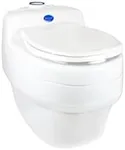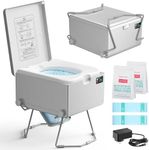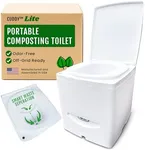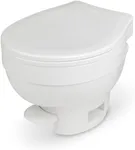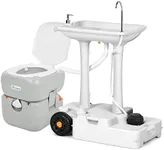Buying Guide for the Best Composting Toilets
Choosing the right composting toilet can transform your off-grid lifestyle, RV, cabin, or even eco-conscious home living. Composting toilets turn human waste into compost through natural processes, reducing the need for plumbing and saving water. To make a good choice, understand your needs—like how often it will be used, who will use it, and in what setting (stationary home, mobile vehicle, outdoor cabin, etc.). Matching these needs with the right features ensures convenience, hygiene, and effective composting.CapacityCapacity refers to how much waste a composting toilet can handle before it needs to be emptied or the composted material must be removed. This is important because it affects how often you’ll need to maintain the toilet—a key consideration for convenience, especially for larger groups or full-time use. Smaller capacity models suit solo users or occasional use (like weekend trips), while larger capacity toilets are better for families or continuous use in a main residence. Consider who will use the toilet and how frequently to decide on the right size.
Ventilation SystemA ventilation system is designed to move air through the toilet, managing odor and speeding up the composting process. Good ventilation is crucial for keeping the composting area dry and odor-free. Systems range from completely passive (using just air movement) to ones with built-in fans for active ventilation. For indoor use, or when odor is a big concern, prioritize strong or powered ventilation. If you’re setting up outdoors or in a very ventilated area, a basic system may suffice.
Liquid and Solid SeparationSome composting toilets separate liquids (urine) from solids (feces), which helps manage odor and speed up composting, since these materials break down best in different conditions. A separation system usually means less smell and easier cleaning, but it might take getting used to or mean slightly more work to empty two containers. For long-term installations, or when maximum odor control is needed, separation is a big advantage, but for occasional or portable use, an all-in-one may be simpler.
Ease of Emptying and MaintenanceThis is about how easy it is to remove the compost or waste and clean the toilet. Some models have removable bins, trays, or rotating drums for hassle-free emptying, while others might require more effort or skill to operate or clean. If you want the process to be as hands-off as possible, look for features that simplify disposal and cleaning. Think about how comfortable you are with performing regular maintenance and how often you’re willing to do it.
Composting Method (Self-Contained vs. Centralized)Composting toilets come in two basic types: self-contained (where all composting happens inside the unit) and centralized (where waste is piped to a remote composting chamber elsewhere in the building). Self-contained models are portable and easy to install, making them ideal for small spaces or mobile setups. Centralized systems can manage higher capacities, require less frequent emptying, and usually handle waste better, but installation and space needs are bigger. Your choice depends on available space, portability needs, and installation willingness.
Power RequirementSome composting toilets require electrical power for ventilation fans, mixing mechanisms, or heating elements to speed up composting or manage odors, while others are totally manual. If you’re setting up off-grid or don’t have easy access to electricity, look for a model designed to run fully without power. If you are in a permanent location and have power available, you might benefit from features that make composting faster and cleaner, but these models will require a reliable energy supply.
Size and FootprintThe physical size of the toilet affects where it can be installed. Compact models fit better in small RVs or cabins, but they may have lower capacity or fewer features. Bigger models offer more comfort and capacity, but need more space. Measure your intended location carefully and consider how much room you’re willing to dedicate to the unit. Match the footprint of the toilet to your installation environment.


